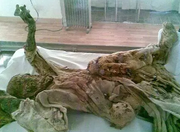The Saltmen were discovered in the Chehrabad salt mines, located on the southern part of the Hamzehlu village, on the west side of the city of Zanjan, in the Zanjan Province in Iran. By 2010 the remains of six men had been discovered, most of them accidentally killed by the collapse of galleries they were working in. The head and left foot of Salt Man 1 are on display at the National Museum of Iran in Tehran.
In the winter of 1993, miners came across a body with long hair, a beard and some artifacts. These included the remains of a body, a lower leg inside a leather boot, three iron knives, a woolen half trouser, a silver needle, a sling, parts of a leather rope, a grindstone, a walnut, some pottery sherds, some patterned textile fragments, and finally a few broken bones. Saltman1 had been buried in the middle of a tunnel approximately 45 metres in length.
In 2004 another salt miner found the remains of a second man. During archaeological excavations in 2005, the remains of another two, well-preserved, men were found. The third, fourth, and the fifth "saltmen" were carbon dated. The third body was dated and placed in 2337 BP, the fourth body in 2301 BP, and the fifth mummy was dated to 2286 BP, placing them all in the Achaemenid period. A sixth corpse found in the excavation of 2010 was left in place at the salt mine. Three hundred pieces of fabric were found, some of which retained designs and dyes.
Studies
Anatomical analysis revealed that the bones previously thought to have belonged to one individual belonged to several, and the previous number of five has since increased to at least 8 individuals. Isotopic analysis of the remains revealed some of them were from the Tehran-Qazvin Plain, which is relatively local to the mine's locality, while others were from North-Eastern Iran and the coastal areas around the Caspian Sea, and a few from as far away as Central Asia
The bodies are dated to the Parthian (247 BCE–224 CE) and Sassanid (224–651 CE) eras, and the remainder to the Achaemenid Dynasty (550–330 BCE).
Pathology
Saltman No. 5 had tapeworm eggs from the Taenia sp. genus in his system.

Saltman #4
The find indicates the consumption of raw or under-cooked meat, and this was the first case of this parasite in ancient Iran and the earliest evidence of ancient intestinal parasites in the area.
The best preserved of the salt men is Saltman No. 4. A sixteen-year-old miner, crushed by a cave-in.
External Links
https://www.atlasobscura.com/places/salt-men-iran
https://www.ancient.eu/article/747/ancient-iranian-salt-mine-mummies/
